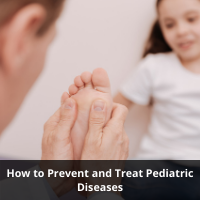How to Prevent and Treat Pediatric Diseases

Children of all ages deserve the top-quality of medical care. Being a parent makes it imperative to know about the most up-to-date treatment guidelines to ensure your child receives the best possible care.
(AAP) or The American Academy of Pediatrics has compiled some general pediatric diseases and recommended treatments. The following information discusses a few treatments which are based on scientific facts and best medical practices. Still, there are valid reasons why your pediatrician approves different treatments for your child, particularly if your little has a pre-existing medical condition. Your doctor at an Ontario Podiatry will guide you with all variations in treatment. If you have any queries about proper care for your kids, please communicate them to your pediatrician.
Common Cold
Viruses in the upper respiratory tract cause colds. Most young ones, especially those in child care, can catch up to 8 colds every year. The general symptoms of a common cold include: congestion, runny nose, and cough can endure for up to ten days.
If you see green mucus in the nose, don’t automatically assume that antibiotics are needed; common colds never require antibiotics. But, if you suspect a sinus infection, your pediatrician will decide whether antibiotics are the ideal choice depending on your kid’s symptoms and a physical exam.
Urinary Tract Infection
Urinary tract infections or UTIs, infamously known as bladder infections, happen when bacteria build up in the urinary tract. Children, infants, teens, and adults all are susceptible to UTI’s. UTI symptoms range from burning or pain during urination, bedwetting, the need to urinate urgently or frequently, abdominal cramps, and back or side pain.
Bacterial Sinusitis
Bacterial sinusitis results from a bacteria trapped in the sinuses. Sinusitis is often the case when cold-related symptoms like daytime cough, nasal discharge, or both last more than ten days without betterment.
You may require antibiotics if this condition co-occurs with a thick yellow nasal discharge and a fever running for 3 to 4 days.
Skin Infection
In many children with skin infections, a skin test (swab or culture) may be necessary to determine the most suitable treatment. Inform your doctor if your child has a history of staph infection, MRSA, or other resistant bacteria and if they have been exposed to other individuals with resistant bacteria, such as family.
Ear Pain
Ear pain is another common illness in children. It has many causes—including ear infection, pressure from a sinus infection or cold, swimmer’s ear (infection in the ear canal), teeth pain spreading from the jaw to the ear, among others. To differentiate, your pediatrician will be examining your child’s ear. An in-office assessment is still the best way for the pediatrician to diagnose accurately. If a high fever accompanies your child’s ear pain, involving both ears, or if your child has other illness symptoms, your pediatrician may determine antibiotic as the best treatment.
The widely-preferred antibiotic is Amoxicillin, mostly used for middle ear infections—unless there is an allergy to penicillin or recurrent or chronic infections.
Bronchitis
Chronic bronchitis is an infection of the central, large airways in the lungs and is most commonly observed in adults. Often the word “bronchitis” is used to refer to a chest virus that does not require antibiotics.
Sore Throat
Sore throats are quite prevalent in young children and can cause severe pain. A sore throat resulting from a virus does not require antibiotics. Those cases require no special medication, and your child’s health should improve in ten days. In a different case, a sore throat could be an indicator of an infection called streptococcal or strep throat.
Strep cannot be accurately detected by only looking at the throat. An in-office rapid strep test or lab test, which entails a quick swab of the throat, is required to confirm strep diagnosis. If your child tests positive for strep, the pediatrician will likely prescribe an antibiotic. It’s vital that your child stays on the antibiotics for the full course, as advised by the doctor, even if the symptoms disappear or get better.
Pain
Acetaminophen and ibuprofen are the most excellent medicines for pain relief in children. Talk to your pediatrician about the right amount of medication to give your child, as it needs to be in accordance with your child’s weight.
Narcotic pain medicines are not proper for little ones having common injuries or complaints like a sprained ankle, sore throat, or ear pain. It would help if you never used Codeine for your children’s treatment because it’s been linked to respiratory complications and even death in children.
What If Symptoms Change?
Sometimes, mild infections—bacterial or viral—can progress into more severe conditions.
Call your doctor if your kid’s illness appears to change, gets worse, does not go away after some days, or if you are worried about a new symptom that may arise.
